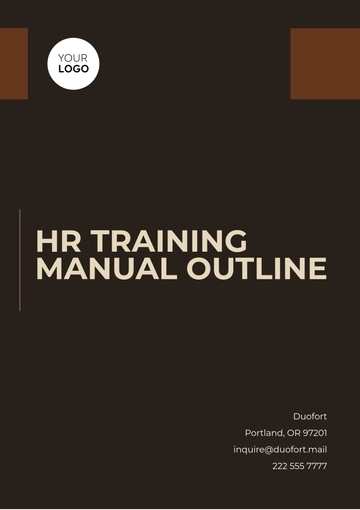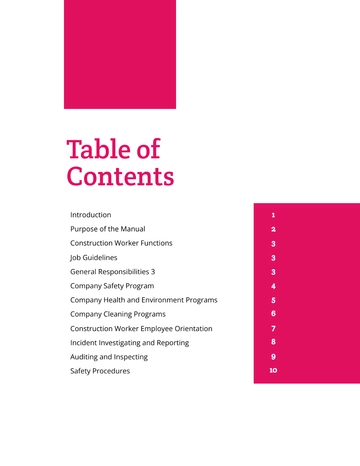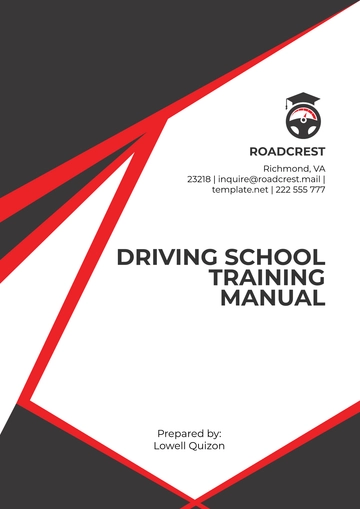Free Printable Bakery Training Manual

I. Introduction
A. Purpose of the Manual
[Your Company Name]'s Bakery Training Manual aims to standardize operational procedures and enhance the efficiency of our bakery staff. It provides a clear framework for performing daily tasks, maintaining high-quality standards, and ensuring a consistent customer experience. The manual serves as a vital resource for both new hires and seasoned employees, ensuring everyone is aligned with our bakery’s best practices. By following these guidelines, staff members can contribute to the bakery’s success and uphold its reputation.
B. Overview of the Bakery
[Your Company Name] specializes in creating artisanal bread, pastries, and other baked goods using traditional techniques and high-quality ingredients. We are committed to excellence in both product quality and customer service, striving to exceed expectations with every order. This section offers an insight into our bakery’s history, mission, and core values, emphasizing our dedication to craftsmanship and innovation. Understanding this overview helps staff appreciate their role in delivering the bakery’s promise to customers.
C. Importance of Training
Effective training is essential for maintaining the high standards of our bakery and ensuring that all employees perform their roles efficiently. It empowers staff with the knowledge and skills necessary to handle daily tasks, address customer needs, and adhere to safety protocols. Continuous training also fosters professional development, leading to a more motivated and skilled team. Regular updates and refresher courses help keep everyone informed of new procedures and best practices.
II. Bakery Operations
A. Daily Opening Procedures
Begin each day by unlocking the bakery and disabling the security system, ensuring that all entry points are secure. Conduct a thorough walk-through to check for any safety hazards or maintenance issues that need immediate attention. Set up workstations, including arranging tools and equipment, and ensure that all items are clean and in good working order. Review inventory levels and restock any items that are low to ensure a smooth start to the day.
B. Daily Closing Procedures
At the end of each shift, clean all workstations and equipment thoroughly to maintain a hygienic environment. Restock ingredients and supplies as needed, checking inventory to prepare for the next day’s operations. Perform a security check to confirm that all doors and windows are locked, and activate the alarm system to secure the premises. Document any issues encountered during the day and address them promptly to prevent future problems.
C. Inventory Management
Monitor stock levels daily by checking inventory records and physical supplies to ensure accuracy. Place orders for ingredients and other supplies as needed, coordinating with vendors to ensure timely delivery and avoid shortages. Conduct a comprehensive inventory audit at the end of each month to reconcile records with actual stock levels and identify any discrepancies. Implement inventory control measures to minimize waste and manage costs effectively.
D. Equipment Maintenance and Usage
Adhere to the manufacturer’s guidelines for operating and maintaining bakery equipment to ensure optimal performance and longevity. Perform routine cleaning, such as removing residues and checking for any signs of wear and tear, to keep equipment in good condition. Address minor repairs promptly and report significant issues to the maintenance team for professional repair. Keep maintenance records up-to-date to track equipment servicing and ensure compliance with safety standards.
III. Product Preparation
A. Ingredient Handling
Store all ingredients according to recommended guidelines, such as temperature and humidity controls, to maintain freshness and prevent spoilage. Check expiration dates regularly and rotate stock to use older ingredients first, minimizing waste and ensuring quality. Follow precise measuring techniques for accuracy in recipes, and use calibrated scales and measuring cups. Keep ingredient storage areas clean and organized to facilitate easy access and prevent cross-contamination.
B. Recipe Instructions
Carefully follow the recipe instructions provided for each product, including specific measurements, mixing times, and baking temperatures. Pay attention to details such as ingredient order and processing times, which are crucial for achieving the desired results. Make adjustments as needed based on product size and environmental factors, such as humidity or altitude. Consistently evaluate the final product to ensure it meets the bakery’s quality standards.
C. Baking Techniques
Preheat ovens to the correct temperature well in advance to ensure even baking from the start. Use appropriate baking pans and liners for each product to achieve the best texture and appearance. Monitor baking times closely, adjusting as necessary to account for variations in oven performance or batch size. Perform regular checks during baking to prevent overcooking or undercooking, and make any necessary adjustments promptly.
D. Quality Control
Implement a rigorous quality control process to evaluate the appearance, texture, and flavor of each baked product. Conduct regular taste tests and visual inspections to ensure consistency and adherence to bakery standards. Address any deviations from quality expectations immediately, making adjustments to recipes or processes as needed. Maintain a log of quality control findings to identify trends and areas for improvement.
IV. Health and Safety
A. Personal Hygiene
All staff members must wash their hands thoroughly with soap and water before handling any food products to prevent contamination. Wear clean uniforms, including aprons, and ensure that hair is tied back and covered if necessary. Avoid touching your face, hair, or personal items while working to maintain hygiene. Follow proper handwashing protocols, including using hand sanitizers where appropriate.
B. Food Safety Standards
Store food items at the recommended temperatures to inhibit bacterial growth and prevent spoilage. Use separate utensils and cutting boards for different types of food, particularly for raw and cooked items, to avoid cross-contamination. Follow proper cooking and reheating techniques to ensure that food reaches safe temperatures. Adhere to guidelines for food handling and storage to maintain high safety standards.
C. Cleaning Procedures
Establish a cleaning schedule that includes regular cleaning of surfaces, equipment, and storage areas using approved cleaning agents. Ensure that all areas are sanitized according to the bakery’s hygiene protocols, including after each use and at the end of the day. Dispose of waste in a timely manner and recycle materials where possible to maintain a clean and eco-friendly environment. Document cleaning activities and any issues encountered for review and follow-up.
D. Handling Allergens
Clearly label all bakery products that contain common allergens such as nuts, dairy, and gluten to inform customers with dietary restrictions. Use separate equipment and utensils to prepare allergen-free products to prevent cross-contamination. Train all staff on allergen awareness and proper handling procedures to ensure safe preparation of allergen-sensitive items. Regularly review and update allergen policies to reflect any changes in ingredients or regulations.
V. Customer Service
A. Customer Interaction Guidelines
Greet every customer warmly and with a friendly demeanor, making them feel welcome from the moment they enter the bakery. Provide clear and accurate information about products, including ingredients and pricing, to assist customers in making informed decisions. Handle special requests and modifications with flexibility and attention to detail, ensuring customer satisfaction. Maintain a positive attitude and professional demeanor at all times, even during busy periods.
B. Order Management
Process customer orders efficiently, ensuring accuracy and timely fulfillment. Verify order details with customers to confirm their preferences and prevent mistakes. Prepare and package orders neatly, ensuring products are presented attractively and securely. Follow up with customers to address any concerns or issues and make necessary corrections promptly.
C. Handling Complaints and Returns
Listen carefully to customer complaints and concerns, showing empathy and understanding. Offer solutions or compensation as appropriate, such as refunds or replacements, to resolve issues to the customer’s satisfaction. Document all complaints and returns, including details of the resolution, to identify patterns and areas for improvement. Use feedback to make necessary adjustments to products or procedures.
D. Maintaining a Positive Customer Experience
Create a welcoming and pleasant atmosphere in the bakery by maintaining clean and well-organized spaces. Ensure that all staff members provide courteous and attentive service, addressing customer needs promptly and effectively. Continuously seek and act on customer feedback to enhance the overall experience and address any areas for improvement. Foster a team-oriented environment that prioritizes customer satisfaction and encourages positive interactions.
VI. Emergency Procedures
A. Fire Safety
Familiarize yourself with the locations of fire extinguishers, fire alarms, and emergency exits within the bakery to ensure quick access in case of a fire.
Regularly participate in fire drills to practice the correct evacuation procedures and ensure you can exit the building swiftly and safely.
Immediately report any fire hazards, such as exposed wiring or flammable materials, to the maintenance team for prompt action.
Ensure that fire extinguishers are regularly inspected and serviced according to safety regulations and that staff are trained in their proper use.
Maintain clear and unobstructed access to all fire exits and equipment to facilitate quick and efficient evacuation during an emergency.
B. First Aid and Accident Reporting
Keep a well-stocked first aid kit readily accessible in the bakery and ensure all staff members know its location.
Administer first aid for minor injuries such as cuts or burns, and seek professional medical attention for more serious accidents or injuries.
Complete and submit an accident report form for any workplace incidents, including details of the accident and actions taken.
Review and discuss accident reports during staff meetings to identify potential safety improvements and prevent future incidents.
Ensure that all staff are trained in basic first aid and emergency response procedures, and regularly update this training as needed.
C. Equipment Failures
Follow the troubleshooting guidelines provided by equipment manufacturers to address common issues before seeking professional help.
Report significant equipment failures or malfunctions to the maintenance team immediately to minimize downtime and prevent further damage.
Document equipment issues and repairs in a maintenance log to track recurring problems and ensure timely resolution.
Perform regular inspections and maintenance of equipment to identify potential issues before they lead to failures.
Train staff to recognize signs of equipment malfunction and to follow proper procedures for reporting and addressing these issues.
D. Evacuation Procedures
Follow the designated evacuation plan for the bakery, which includes the safest and quickest routes to exit the building.
Ensure that all staff members and customers are calmly directed to the nearest exit during an emergency evacuation.
Conduct regular evacuation drills to familiarize staff with the procedures and to identify any areas for improvement.
Designate a meeting point outside the bakery where everyone can gather and account for all personnel and customers.
Review and update the evacuation plan as needed, especially if there are changes to the bakery layout or staff responsibilities.
VII. Staff Responsibilities
A. Roles and Duties
Clearly define and communicate the specific roles and responsibilities for each staff position to ensure efficient bakery operations.
Provide detailed job descriptions and expectations for each role, including daily tasks and long-term responsibilities.
Ensure that staff members are aware of their individual duties and understand how they contribute to the overall success of the bakery.
Encourage staff to take initiative and seek guidance if they are unsure about their responsibilities or how to perform certain tasks.
Regularly review and update roles and responsibilities as needed to accommodate changes in bakery operations or staffing.
B. Shift Scheduling
Create a shift schedule that provides adequate coverage during all operating hours and accommodates staff availability and preferences.
Post schedules in advance and communicate any changes promptly to allow staff to adjust their plans accordingly.
Address any scheduling conflicts or concerns in a fair and timely manner, and ensure that all staff members are aware of the procedures for requesting time off.
Monitor attendance and punctuality, and address any issues or patterns of absenteeism with staff members to maintain operational efficiency.
Use scheduling software or tools to streamline the scheduling process and keep accurate records of staff shifts and hours worked.
C. Training and Development
Provide initial training for new hires that covers all aspects of bakery operations, including procedures, safety protocols, and customer service.
Offer ongoing training and professional development opportunities to help staff enhance their skills and advance their careers.
Schedule regular refresher courses to update staff on any changes to procedures or policies and to reinforce best practices.
Encourage staff to participate in external training programs or industry events to stay current with trends and advancements in the bakery field.
Evaluate the effectiveness of training programs through feedback and performance assessments, and make adjustments as necessary to meet staff needs.
D. Performance Evaluation
Conduct regular performance evaluations to provide feedback to staff members on their strengths, areas for improvement, and overall contributions to the bakery.
Set clear, achievable goals for each staff member and provide support and resources to help them meet these objectives.
Recognize and reward exceptional performance through positive reinforcement, such as employee of the month awards or performance-based incentives.
Address performance issues with constructive feedback and develop action plans to help staff improve their performance.
Use performance evaluations to identify training needs and opportunities for career advancement within the bakery.
VIII. Bakery Policies
A. Attendance and Punctuality
Adhere to the bakery’s attendance policy by arriving on time for scheduled shifts and notifying management in advance of any absences.
Document and report any instances of tardiness or unplanned absences, and follow the procedures for requesting time off.
Address any patterns of absenteeism or punctuality issues with staff members to ensure consistent and reliable staffing.
Offer support and flexibility where possible to accommodate legitimate needs while maintaining operational efficiency.
Ensure that all staff members are familiar with and understand the attendance and punctuality policies to foster accountability.
B. Dress Code and Personal Appearance
Adhere to the bakery’s dress code by wearing the required uniform, including clean aprons and appropriate footwear, to maintain a professional appearance.
Maintain personal hygiene by keeping hair neatly groomed and avoiding excessive jewelry or accessories that could interfere with food preparation.
Ensure that uniforms are clean and in good condition, and replace any worn or damaged items promptly.
Follow grooming standards to present a professional and hygienic image to customers and colleagues.
Address any issues related to personal appearance or dress code violations promptly and respectfully to ensure compliance with bakery policies.
C. Code of Conduct
Exhibit professional behavior at all times, including respectful interactions with colleagues and customers, and adherence to ethical standards.
Avoid conflicts of interest by disclosing any potential issues and refraining from engaging in activities that could compromise the bakery’s integrity.
Follow all company policies and procedures, including those related to confidentiality, security, and workplace behavior.
Promote a positive work environment by contributing to teamwork and collaboration, and addressing any interpersonal conflicts constructively.
Uphold the bakery’s values and mission by demonstrating commitment to quality, customer service, and operational excellence.
D. Confidentiality and Security
Protect sensitive information, including customer data and proprietary recipes, by following confidentiality policies and secure handling practices.
Secure personal belongings and sensitive documents by using designated storage areas and locking up valuables as needed.
Report any security breaches or concerns, such as unauthorized access or suspicious activities, to management immediately.
Adhere to data protection regulations and ensure that customer and business information is handled in accordance with privacy laws.
Regularly review and update security protocols to address any new risks or changes in bakery operations.
- 100% Customizable, free editor
- Access 1 Million+ Templates, photo’s & graphics
- Download or share as a template
- Click and replace photos, graphics, text, backgrounds
- Resize, crop, AI write & more
- Access advanced editor
Optimize your bakery’s training with the Printable Bakery Training Manual Template from Template.net. Fully editable and customizable, this template adapts to your bakery’s unique needs. Utilize the AI Editor Tool for seamless updates and enhancements. Streamline your training process with a professional, user-friendly manual designed to elevate staff performance and ensure consistency.





























